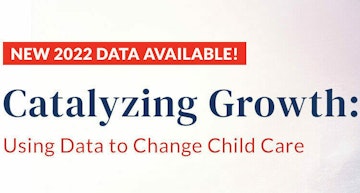Child Care Aware® of America 2022 Report: Using Data to Change Child Care

Each year, Child Care Aware® of America (CCAoA) releases updates to its series of reports, Catalyzing Growth: Using Data to Change Child Care. Here’s a detailed summary of this year’s release which includes new child care supply, quality and affordability data from 2022.
An analysis conducted by the CCAoA in 2022 revealed some key trends in child care supply and affordability. The study found that there was a slight increase in the number of licensed child care centers, reaching 93,124 in 2022, exceeding pre-pandemic levels. However, the number of family child care (FCC) homes continued to decline, although at a slower rate compared to previous years, with approximately 2% fewer homes open in 2022.
Child care affordability remained a significant concern, with the national average price for child care in 2022 calculated at $10,853 annually. This cost would consume 10% of the median income for a married couple with children and 33% of the median household income for a single parent. These figures surpassed the U.S. Department of Health and Human Services’ recommendation that child care should not exceed 7% of annual income.
While child care prices continued to rise in 2022, the rate of increase was slower compared to previous years, and it did not outpace inflation. In fact, inflation outpaced child care cost increases by 7%, likely due to uncharacteristic increases in inflation that year.
However, child care expenses still exceeded many family household expenses. In 41 states and the District of Columbia, the annual price of child care for two children in a center exceeded average annual mortgage payments by up to 53%. Similarly, the price of center-based care for two children exceeded average annual rent payments from 24% to over 100% in all 50 states and the District of Columbia.
The analysis also highlighted regional disparities, with child care prices surpassing housing costs in the Midwest, the Northeast, and the South. Additionally, child care costs exceeded annual in-state university tuition in all four regions.
The report emphasized the importance of investment in child care, citing the positive impact of federal relief funding and state-level policies. The modest growth in child care centers in 2022 was attributed to these investments. However, sustained efforts are necessary to address the ongoing decline in FCC homes and to ensure affordable, accessible, and high-quality child care. Increased funding is needed to bridge the gap between the prices families pay and the true costs of providing quality care, particularly for infants and toddlers. Without continued investment, the positive trends seen in 2022 may not continue, leaving families with limited options for child care.
Stay up to date with Child Care Matters™
Stay current about new features, industry news, and ideas to inspire innovation in the ECE system.
Unsubscribe whenever you want.
Stay up to date with Child Care Matters™
Stay current about new features, industry news, and ideas to inspire innovation in the ECE system.
Unsubscribe whenever you want.